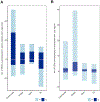Transcriptome-wide In Vitro Effects of Aspirin on Patient-derived Normal Colon Organoids
- PMID: 34389629
- PMCID: PMC8639779
- DOI: 10.1158/1940-6207.CAPR-21-0041
Transcriptome-wide In Vitro Effects of Aspirin on Patient-derived Normal Colon Organoids
Abstract
Mechanisms underlying aspirin chemoprevention of colorectal cancer remain unclear. Prior studies have been limited because of the inability of preclinical models to recapitulate human normal colon epithelium or cellular heterogeneity present in mucosal biopsies. To overcome some of these obstacles, we performed in vitro aspirin treatment of colon organoids derived from normal mucosal biopsies to reveal transcriptional networks relevant to aspirin chemoprevention. Colon organoids derived from 38 healthy individuals undergoing endoscopy were treated with 50 μmol/L aspirin or vehicle control for 72 hours and subjected to bulk RNA sequencing. Paired regression analysis using DESeq2 identified differentially expressed genes (DEG) associated with aspirin treatment. Cellular composition was determined using CIBERSORTx. Aspirin treatment was associated with 1,154 significant (q < 0.10) DEGs prior to deconvolution. We provide replication of these findings in an independent population-based RNA-sequencing dataset of mucosal biopsies (BarcUVa-Seq), where a significant enrichment for overlap of DEGs was observed (P < 2.2E-16). Single-cell deconvolution revealed changes in cell composition, including a decrease in transit-amplifying cells following aspirin treatment (P = 0.01). Following deconvolution, DEGs included novel putative targets for aspirin such as TRABD2A (q = 0.055), a negative regulator of Wnt signaling. Weighted gene co-expression network analysis identified 12 significant modules, including two that contained hubs for EGFR and PTGES2, the latter being previously implicated in aspirin chemoprevention. In summary, aspirin treatment of patient-derived colon organoids using physiologically relevant doses resulted in transcriptome-wide changes that reveal altered cell composition and improved understanding of transcriptional pathways, providing novel insight into its chemopreventive properties. PREVENTION RELEVANCE: Numerous studies have highlighted a role for aspirin in colorectal cancer chemoprevention, though the mechanisms driving this association remain unclear. We addressed this by showing that aspirin treatment of normal colon organoids diminished the transit-amplifying cell population, inhibited prostaglandin synthesis, and dysregulated expression of novel genes implicated in colon tumorigenesis.
©2021 American Association for Cancer Research.
Conflict of interest statement
Disclosures
The authors declare that there are no conflict of interests.
Figures




Similar articles
-
Novel insights into the molecular mechanisms underlying risk of colorectal cancer from smoking and red/processed meat carcinogens by modeling exposure in normal colon organoids.Oncotarget. 2021 Sep 14;12(19):1863-1877. doi: 10.18632/oncotarget.28058. eCollection 2021 Sep 14. Oncotarget. 2021. PMID: 34548904 Free PMC article.
-
Transcriptomic Response to Calcium in Normal Colon Organoids is Impacted by Colon Location and Sex.Cancer Prev Res (Phila). 2022 Oct 4;15(10):679-688. doi: 10.1158/1940-6207.CAPR-22-0068. Cancer Prev Res (Phila). 2022. PMID: 36095330 Free PMC article.
-
CRISPR/Cas9-mediated heterozygous knockout of the autism gene CHD8 and characterization of its transcriptional networks in cerebral organoids derived from iPS cells.Mol Autism. 2017 Mar 20;8:11. doi: 10.1186/s13229-017-0124-1. eCollection 2017. Mol Autism. 2017. PMID: 28321286 Free PMC article.
-
Mechanisms of Colorectal Cancer Prevention by Aspirin-A Literature Review and Perspective on the Role of COX-Dependent and -Independent Pathways.Int J Mol Sci. 2020 Nov 27;21(23):9018. doi: 10.3390/ijms21239018. Int J Mol Sci. 2020. PMID: 33260951 Free PMC article. Review.
-
Prevention of colon cancer and modulation of aberrant crypt foci, cell proliferation, and apoptosis by retinoids and NSAIDs.Adv Exp Med Biol. 1999;470:55-63. doi: 10.1007/978-1-4615-4149-3_6. Adv Exp Med Biol. 1999. PMID: 10709674 Review.
Cited by
-
Genomic and cellular responses to aspirin in colonic organoids from African- and European-Americans.Physiol Genomics. 2025 Mar 1;57(3):103-114. doi: 10.1152/physiolgenomics.00015.2024. Epub 2025 Jan 15. Physiol Genomics. 2025. PMID: 39812338 Free PMC article.
-
Stem Cell Models for Cancer Therapy.Int J Mol Sci. 2022 Jun 24;23(13):7055. doi: 10.3390/ijms23137055. Int J Mol Sci. 2022. PMID: 35806056 Free PMC article. Review.
-
Novel insights into the molecular mechanisms underlying risk of colorectal cancer from smoking and red/processed meat carcinogens by modeling exposure in normal colon organoids.Oncotarget. 2021 Sep 14;12(19):1863-1877. doi: 10.18632/oncotarget.28058. eCollection 2021 Sep 14. Oncotarget. 2021. PMID: 34548904 Free PMC article.
-
Genomic and epigenomic responses to aspirin in human colonic organoids.Physiol Genomics. 2023 Mar 1;55(3):101-112. doi: 10.1152/physiolgenomics.00070.2022. Epub 2023 Jan 16. Physiol Genomics. 2023. PMID: 36645669 Free PMC article.
-
Transcriptomic Response to Calcium in Normal Colon Organoids is Impacted by Colon Location and Sex.Cancer Prev Res (Phila). 2022 Oct 4;15(10):679-688. doi: 10.1158/1940-6207.CAPR-22-0068. Cancer Prev Res (Phila). 2022. PMID: 36095330 Free PMC article.
References
Publication types
MeSH terms
Substances
Grants and funding
LinkOut - more resources
Full Text Sources
Molecular Biology Databases
Research Materials
Miscellaneous

